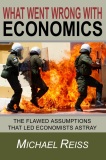There seems to be little agreement about how the "money supply" should be defined, and I'm just now beginning to understand why. This can by illustrated by first giving my definition:
The money supply is the sum, for all people and businesses, at any single instant, of the answer to the question "How much money do you have at this instant that you are freely and legally able to buy things with".
At this point you may be thinking that this "definition" is rather sloppy because "freely" is rather vague. My answer to this criticism would be "Exactly! - and that's why economists can not agree of a more formal definition".
Its rather like the problems definition of defining almost any complex item. Say for example a "car". Imagine you had a slicing machine that could cut off thin slices of a car one by one. At what point would the remaining chunk of metal fail the definition of a car... its not so clear. Indeed it makes far more sense to say that its actually a "matter of degree" i.e. as the car gets slices taken off it becomes less and less like a car.
So now as an example, take a debatable point within the definition of the money supply - time deposits. If the time deposits are strictly enforced, i.e. there is no possibility at all of getting your money out early, then clearly this can not be considered part of the money supply. But what if you can take the money out early with some penalty - now its a grey area! Under my sloppy definition, I'd say the the degree to which the time deposit is part of the money supply is a function of the size and form of the penalty.
Wednesday, 24 November 2010
Subscribe to:
Post Comments (Atom)




I'm going to suggest looking at the problem as a couple of separate issues.
ReplyDeleteI think the important part of the question of, what is the money supply, is in some sense the answer to the question, what are banks allowed to perform fractional reserve based lending against? Because this is where the variation comes from.
Historically incidentally, up to the mid-1930's, economists defined money as physical notes and coins, and the fiscal reality and role of bank deposits was a matter for debate. It still is in some quarters.
So define the money supply as the sum of all notes, coins and bank deposits in the economy.
The question then i think you're trying ask is slightly different, which is what part of the money supply is in active use - and what part is acting as a buffer? The store of value as economists call it.
Statistically, for sufficiently large countries, i think it's reasonable to assume this is fairly constant in the short term as money flows operate, but it could change over longer terms. It could also respond to crises - for example a food shortage would suck money out of the buffer, which would increase the price signal for food - which in terms of the required meta-economic response - grow more food - would be a good thing.
But it can also be a problem as it is now, if due to bugs in the monetary regulation you have money pooling up in fewer and fewer hands, where its both removed from the active side, causing deflation, and creating control issues with concentrated wealth.
So that's how I would look at it from a distributed systems perspective at any rate.